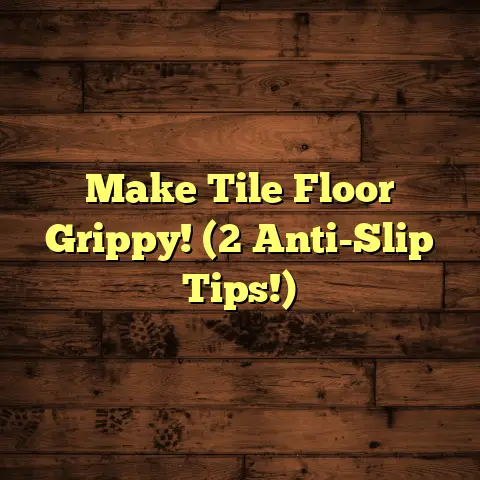Buffing vs. Refinishing Hardwood? (Costly Mistake!)
As a flooring contractor with years of experience, I’ve seen firsthand how crucial it is to understand the difference between buffing and refinishing your hardwood floors.
Trust me, choosing the wrong method can be a costly mistake.
Let’s dive in and make sure you’re equipped to make the best decision for your beautiful floors!
Understanding Hardwood Flooring
The Basics of Hardwood Floors
First things first, let’s talk about the basics. Hardwood floors aren’t all created equal.
You’ve got solid hardwood, which is
exactly what it sounds like: a solid
piece of wood.
It’s classic, durable,
and can be refinished multiple times.
Then there’s engineered hardwood, which consists of a thin layer of real hardwood on top of multiple layers of plywood.
It’s more resistant to moisture and temperature changes than solid wood, but can only be refinished a limited number of times, depending on the thickness of the top layer.
The typical lifespan of a hardwood floor can range from 25 to 100 years or more, depending on the type of wood, the quality of the installation, and how well it’s maintained.
Regular sweeping, vacuuming, and occasional cleaning with a wood floor cleaner are essential.
But the finish? That’s the real hero in protecting your hardwood.
The Role of Finishing
Think of the finish as a shield for
your wood.
It protects against
scratches, stains, and everyday wear
and tear.
There are several types of finishes, each with its own pros and cons.
Polyurethane: This is a popular choice because it’s durable and water-resistant.
It comes in both oil-based and water-based options.Oil-based Polyurethane: Tends to amber over time, giving a warm, classic look.
It’s durable but has a strong odor and longer drying time.-
Water-based Polyurethane: Is clearer, doesn’t amber as much, has lower VOCs (volatile organic compounds), and dries faster.
-
Penetrating Oil Finishes: Like tung oil or linseed oil, penetrate the wood fibers and harden, providing a natural look and feel.
They require more maintenance but are easy to spot-repair.
-
Wax Finishes: Offer a beautiful luster but are the least durable and require frequent waxing.
Over time, all finishes wear down.
Foot traffic, pets, and even sunlight
can take their toll.
Small scratches and scuffs can appear, and the finish can become dull or worn in high-traffic areas.
This is where the decision between buffing and refinishing comes in.
Buffing Hardwood Floors
What is Buffing?
Buffing, also known as “screen and recoat,” is like a mini-makeover for your floors.
It involves lightly abrading the existing finish to remove minor scratches and imperfections, then applying a fresh coat of finish.
Think of it as exfoliating and moisturizing your skin!
The process typically involves using a floor buffer (a machine with a rotating pad) and a fine-grit abrasive screen or pad to lightly scuff the surface.
This creates a smooth surface for the new coat of finish to adhere to.
Advantages of Buffing
One of the biggest advantages of buffing is its cost-effectiveness. It’s significantly cheaper than refinishing because it requires less time, labor, and materials.
Plus, the turnaround time is quick. A buff and recoat can often be completed in a day or two, minimizing disruption to your home.
Buffing is ideal for floors with light scratches, surface wear, or a dull finish.
If your floors are generally in good condition but just need a little pick-me-up, buffing can be a great option.
Limitations of Buffing
Now, let’s be real. Buffing isn’t a magic bullet. It has its limitations.
If your floors have deep scratches, gouges, or significant damage, buffing won’t be enough to fix the problem.
It only addresses the surface finish, not the wood itself.
Also, buffing won’t remove stains or repair areas where the finish has completely worn away, exposing the bare wood.
One common misconception is that buffing can restore floors that haven’t been properly maintained.
If your floors are severely worn or have multiple layers of old wax or polish buildup, buffing can actually make the problem worse.
Refinishing Hardwood Floors
What is Refinishing?
Refinishing is the ultimate transformation for your hardwood floors.
It involves sanding down the existing finish and any surface imperfections, staining the wood (if desired), and applying several coats of new finish.
It’s like giving your floors a fresh start!
The process typically involves using a drum sander or an orbital sander to remove the old finish and level the floor.
Edgers are used to sand along the edges of the room and in corners.
Once the floor is sanded smooth, it
can be stained to change the color
or left natural.
Finally, several
coats of finish are applied to protect
the wood and provide a durable surface.
Benefits of Refinishing
The biggest benefit of refinishing is that it can restore your floors to their original beauty.
It removes years of wear and tear, revealing the natural grain and character of the wood.
Refinishing also provides long-term protection against wear and damage.
The new coats of finish create a durable barrier that can withstand heavy foot traffic, spills, and other everyday challenges.
Plus, refinishing gives you customization options. You can choose a new stain color to update the look of your floors or select a different type of finish to achieve a specific sheen level (matte, satin, semi-gloss, or gloss).
Drawbacks of Refinishing
Of course, refinishing also has its
drawbacks.
The cost is significantly
higher than buffing due to the
increased time, labor, and materials involved.
The process is also more disruptive. Refinishing can take several days or even a week to complete, and you’ll need to move all furniture out of the room.
There’s also the issue of dust and fumes. Sanding creates a lot of dust, even with dust collection systems.
And some finishes, especially oil-based polyurethane, can have strong odors and require good ventilation.
Finally, you’ll need to factor in drying time. Each coat of finish needs to dry completely before the next coat can be applied, and you’ll need to wait a few days before you can walk on the floors or replace the furniture.
Comparing Buffing and Refinishing
Cost Analysis
Let’s break down the costs.
Buffing
typically costs between $1 to $3 per
square foot, including labor and materials.
Refinishing, on the other hand, can range from $3 to $8 per square foot or more, depending on the complexity of the job and the type of finish you choose.
Don’t forget to factor in hidden costs. If you choose to buff when refinishing is needed, you may end up having to refinish sooner than expected, costing you more in the long run.
Time Considerations
Buffing is a quick process, usually taking one to two days to complete.
Refinishing is more time-consuming, typically requiring three to seven days or more, depending on the size of the area and the number of coats of finish.
Consider the impact on your daily
life. Can you live without access to
the room for several days?
Do you have
pets or children who could be affected
by the dust and fumes?
Quality of Results
The visual and tactile differences between buffed and refinished floors can be significant.
Buffing will improve the appearance of floors with minor surface wear, but it won’t eliminate deep scratches or restore areas where the finish is completely gone.
Refinishing, on the other hand, can completely transform the look and feel of your floors, making them look brand new.
In terms of long-term results, refinishing will provide a more durable and long-lasting finish than buffing.
A properly refinished floor can last for 10 years or more before needing another refinishing, while a buffed floor may need to be recoated every one to three years.
When to Choose Buffing vs. Refinishing
So, when should you choose buffing and when should you choose refinishing?
Here are a few case studies to help you decide:
Scenario 1: You have a young family with active kids and pets.
Your floors have some light scratches and scuffs, but are generally in good condition.Recommendation: Buffing.
A buff and recoat can refresh the finish and provide some added protection without the expense and disruption of refinishing.Scenario 2: You’ve just purchased an older home with hardwood floors that are severely worn, stained, and have deep scratches.
Recommendation: Refinishing.
Refinishing is the only way to restore the floors to their former glory and create a durable, long-lasting finish.Scenario 3: You want to change the color of your hardwood floors to match your new décor.
Recommendation: Refinishing.
Refinishing allows you to stain the wood to your desired color, completely transforming the look of your floors.
Ultimately, the decision depends on the condition of your floors, your budget, and your aesthetic goals.
If you’re unsure, it’s always best to consult with a professional flooring contractor who can assess your floors and provide personalized recommendations.
The Costly Mistake: Choosing the Wrong Method
Consequences of Improper Maintenance
I’ve seen firsthand the consequences of homeowners choosing the wrong method.
I remember one client who tried to save money by buffing their floors when they really needed refinishing.
Within a year, the finish started peeling and the scratches became even more noticeable.
They ended up having to refinish the floors anyway, costing them more in the long run.
Another client attempted to refinish their floors themselves without proper knowledge or equipment.
They ended up damaging the wood and had to hire a professional to fix their mistakes.
These are just a few examples of how improper maintenance decisions can lead to financial headaches and frustration.
Impact on Home Value
Don’t underestimate the impact of your flooring on your home’s value.
According to the National Association of Realtors, hardwood floors are one of the most appealing features to potential homebuyers.
Well-maintained hardwood floors can significantly increase your home’s value, while damaged or poorly maintained floors can detract from its appeal.
Real estate agents often advise sellers to refinish their hardwood floors before putting their home on the market.
It’s an investment that can pay off handsomely in the form of a higher selling price.
Future Trends in Hardwood Maintenance
The world of flooring is constantly
evolving.
There are always new
innovations in flooring care and maintenance.
One trend I’m seeing is the increasing popularity of water-based finishes.
They’re more environmentally friendly than oil-based finishes, have lower VOCs, and dry faster.
Another trend is the use of dustless sanding systems, which minimize the amount of dust produced during the refinishing process.
Homeowners are also becoming more aware of the importance of regular maintenance and are investing in high-quality cleaning products and equipment to keep their floors looking their best.
Conclusion: Making an Informed Choice for Your Hardwood Floors
So, there you have it! The lowdown on buffing versus refinishing.
As we look to the future, the choices we make today regarding our hardwood flooring can have lasting effects.
By understanding the distinctions between buffing and refinishing, you can avoid costly mistakes and ensure your floors remain beautiful and durable for years to come.
The right maintenance choice will not only enhance the aesthetic appeal of your home but also protect your investment, offering peace of mind as you step into the future of your living space.
Remember, your floors are an investment.
Treat them right, and they’ll reward
you with years of beauty and enjoyment!





